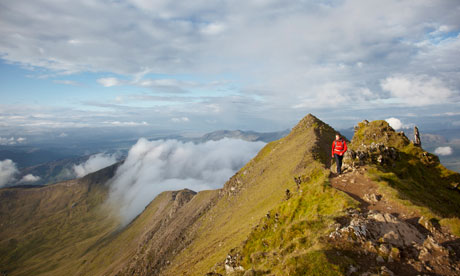
The highest peak south of the Scottish Highlands, Snowdon is a complex massif of radial ridges leading up to the high point, Yr Wyddfa (1,085m). Ice-scoured cirques, sculpted narrow crests and towering cliffs all add to its attraction. I first climbed it by myself as a 13-year-old in snowy conditions at Easter 1960 – up by the Snowdon Ranger path and down by the Watkin.
It was exhilarating and mind-blowing, the memories remain clear to this day. I've been to the top hundreds of times since that first wonderful adventure. The peak's graceful pyramid dominates the view north from where I now live. The classic circuit is the Snowdon Horseshoe. One of the finest scrambling expeditions in Britain, this takes in the satellite peaks of Crib Goch, Garnedd Ugain and Lliwedd. You'll need proper footwear and clothing, a seriously good head for heights to cope with the huge drops either side of Crib Goch's knife-edge ridge, and if there's snow lying, a thorough versing in the equipment and techniques of winter mountaineering.
Of the ordinary routes, it's a choice between half-a-dozen main ones, and innumerable variants for personal discovery. The easiest and busiest is the Llanberis path: park in the town, walk up the road just beyond the mountain railway station and you'll find it. Alleviated only by the locally run cafe at Halfway House (no phone, no bookings, good cake and home-made lemonade) – much better than the over-priced summit "hotel" – this tedious slog closely follows the Snowdon Mountain Railway line. When the latter's banked out by winter snow, the section that traverses over the cliffs of Clogwyn Coch is a notorious accident blackspot. Keep left when ascending to avoid it.
The Pig and the Miners' tracks, both starting from Pen-y-Pass car-park at the head of the Llanberis Pass, have the least amount of climbing – hence nose-to-tail popularity. Enclosed for most of the way, their joint final section, known as the Zig-Zags, is another winter red zone, as is the horrid last loose-scree diagonal traverse on the Watkin Path, which starts from the car park at Bethania, near to sea-level on the south side of the mountain, hence much climbing.
My favourites routes – and the longest-established – approach from the west and have glorious views back along the Lleyn peninsula. (If you can see the Wicklow Hills in Ireland from here, it's going to rain, and if you can't, it's already raining.) The Snowdon Ranger path starts from the youth hostel of that name (0845 371 9659, yha.org.uk/hostel/snowdon-ranger) on the road between Caernarfon and Beddgelert. The Rhyd Ddu path sets off from the village and gains the summit by way of the Clawdd Coch ridge. This airy arete sets the senses of Wordsworth (who failed to reach the top) and his fellow-romantics reeling, often reducing them to hands and knees. Good elevated fun it is, even if too much for the poetic imagination! It's the way I'd recommend.
For refreshment afterwards, join the queue for chips and pint mugs of tea at Pete's Eats (40 High Street, petes-eats.co.uk) in Llanberis, and eat and drink at communal tables. If it's beer you're after, head for the hostelries of Beddgelert or Betws y Coed, both of which also have accommodation. My favourite is the Bryn Tyrch Hotel in Capel Curig (01690 720223, bryntyrchinn.co.uk, doubles from £80 B&B), with great views, real ale, substantial food, and soft beds to relax those aching muscles and joints! Last piece of advice: GPS devices have grave shortcomings when it comes to finding your way around the mountain in mist. Best to learn the old-fashioned skills of navigation by map-and-compass first.
Snowdon: The Story of a Welsh Mountain by Jim Perrin is published by Gomer Press (gomer.co.uk, £14.99)

